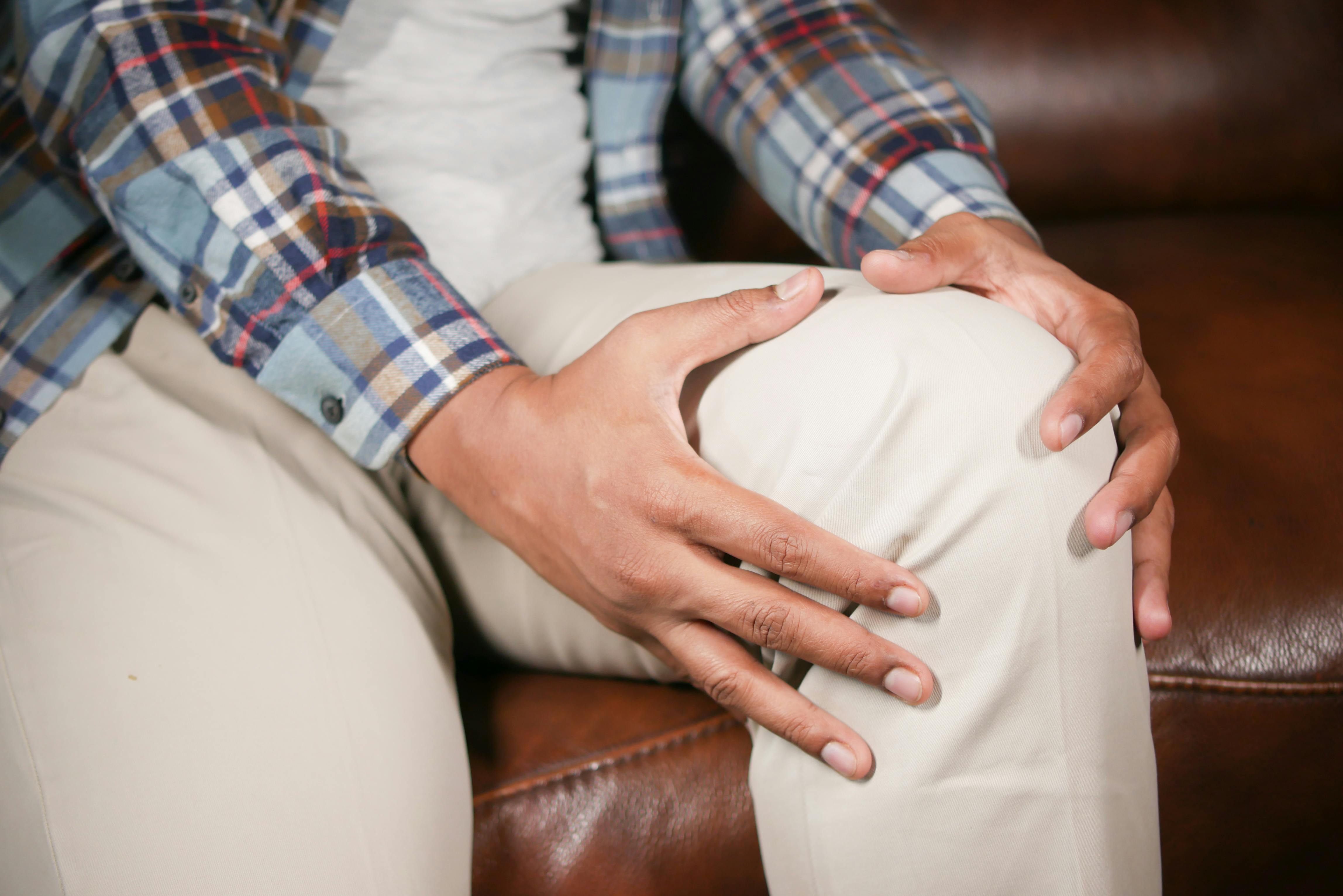Knee Sprains: Must-Know Details Revealed(Treatment and Causes)

Imagine this: You're out enjoying your favorite activities—maybe kicking a soccer ball, gliding down a ski slope, or simply strolling along—and suddenly, your knee decides to play a trick on you. It gives out, leaving you surprised and uncomfortable. Sounds familiar? You might be dealing with a knee sprain. But don't fret! It's a common issue, and with the right care, you'll be back on your feet in no time.
Let’s take a further look into knee sprain in this article.
Table of Contents
- What Is a Knee Sprain?
- Types of Knee Sprain
- Causes Knee Sprain
- Knee Sprain vs Knee Tear
- Knee Sprain Symptoms & Signs
- Knee Sprain Diagnosis
- Knee Sprain Treatment
- When to consider Knee Surgery
- Knee Sprain Recovery Time
- Recovery Techniques for Knee Sprain
- Medical Remedies for Knee Sprain
- Rehabilitation Exercises for Knee Sprain
- Sleeping Strategies for Comfort with a Knee Sprain
- Bottom Line
What Is a Knee Sprain?
A knee sprain occurs when the ligaments in or around your knee are stretched out improperly. Ligaments are like strong bands that hold your bones in place and help stabilize your knee joint. Some sprains are minor and won't disrupt your movements much, while others can affect your daily activities more significantly.
If you've had a knee sprain, it's likely that you've stretched or torn one of the four main ligaments in your knee:
- Anterior cruciate ligament (ACL)
- Posterior cruciate ligament (PCL)
- Medial collateral ligament (MCL)
- Lateral collateral ligament (LCL)
The ACL and PCL are located inside the knee joint, while the MCL and LCL are found on the sides. Knowing which ligament is affected can help determine the best course of treatment.
Types of Knee Sprain
Knee sprains can range from a slight stretch to a complete tear of the ligament, with three main types:
- Grade 1: Involves a mild stretch of the ligament, causing pain and swelling.
- Grade 2: Results in a partial tear of the ligament, often causing significant pain and disability.
- Grade 3: Indicates a complete tear of the ligament, which may require surgical intervention.
In terms of anatomy, knee sprains commonly affect the medial collateral ligament (MCL), located on the inner side of the knee, and either the lateral collateral ligament or the anterior cruciate ligament (ACL), situated deep within the knee joint.
Occasionally, the posterior cruciate ligament (PCL) may also sustain injury, although this is less common. Understanding the specific ligaments involved helps in diagnosing and treating knee sprains effectively.
Causes Knee Sprain
The most common knee ligament injury involves the medial collateral ligament (MCL). Typically, this occurs due to a blow to the outer part of the knee, often when the foot lands forcefully while being struck. Such impact can cause the knee to bend inward, stretching the MCL. Symptoms may include pain and tenderness. It's essential to seek medical attention if you experience anything beyond mild discomfort.
On the other hand, injuries to the anterior cruciate ligament (ACL) often result from occupational or athletic trauma, particularly in sports requiring sudden changes in speed and direction like football or basketball. An ACL tear may be accompanied by a popping sound and instability in the knee.
Also read Knee Replacement Explained- Things you Need to Know
Knee Sprain vs Knee Tear
When you experience a knee sprain, it means one of the major ligaments in your knee has been stretched beyond its limit due to a particular movement. Unfortunately, knee sprains can happen to anyone and are often associated with activities like sports or sudden movements. Symptoms of a knee sprain include swelling, bruising, pain, a popping noise at the time of injury, limited range of motion, and stiffness.
As the knee joint bears significant pressure and undergoes wear and tear over time, it's essential to address knee injuries promptly to prevent further complications. Initially, there may be minimal pain, but inflammation can increase afterward, leading to discomfort.
Treatment for a torn knee typically involves the following steps:
- Rest: Limit activities that aggravate the injury to allow the knee to heal.
- Ice: Apply ice packs to the knee for 15 minutes at a time to reduce pain and swelling.
- Compression: Use a compression bandage to support the knee and reduce swelling.
- Elevation: Elevate the knee with a pillow to further reduce swelling.
- Over-the-counter medication: Take pain relievers as needed to manage discomfort.
- Stretching exercises: Incorporate gentle stretching exercises as recommended to improve flexibility and strength.
My opinion emphasizes the importance of seeking medical attention for a torn knee, especially if symptoms persist or worsen.
The key difference lies in the severity of the injury and the individual's symptoms and functional limitations. While mild knee sprains may improve with conservative measures like rest and ice, more severe cases may require medical intervention to ensure proper healing and prevent long-term complications.
Also read How to prevent knee sprains (Guidelines)
Knee Sprain Symptoms & Signs
The typical symptoms of knee sprains include:
- Pain and swelling in the affected area.
- Discoloration of the skin around the knee.
- Bruising may also occur.
- Difficulty walking properly, often due to pain.
- In severe cases, there might be some instability in the knee.
These symptoms usually appear shortly after the injury, but in some instances, they may develop a day or two later. If you experience any of these symptoms, it's important to seek medical attention for proper evaluation and treatment.
Knee Sprain Diagnosis
To diagnose a sprained knee, a healthcare provider will conduct a physical examination. They will carefully assess your injured knee, checking your range of motion and comparing it to your uninjured knee. It's essential to inform your provider about when you first noticed symptoms and any specific circumstances surrounding the injury.
During the physical exam, your provider may perform clinical tests involving various movements or positions to help diagnose or rule out other types of injuries. These tests can be done without special equipment, and your provider will guide you through them, instructing you to lie down, sit, or stand in specific positions while they move your knee
In addition to the physical exam, your provider may use imaging tests to obtain detailed pictures of your knee joint and surrounding tissues. These tests may include knee X-rays, ultrasound, or magnetic resonance imaging (MRI). These imaging techniques help your provider assess the extent of the injury and develop an appropriate treatment plan.
Knee Sprain Treatment
If you've sprained your knee, managing symptoms at home is possible, but it's crucial to see a healthcare provider first for a proper diagnosis and to ensure no further damage has occurred inside your knee.
The most common treatment for knee sprains Knee Sprain Treatment Guidelines:
- Protect and Rest:
- Limit activity and movements to what's comfortable (around 3 out of 10 on the pain scale).
- Consider using crutches if the knee is painful and swollen.
- Keep Moving:
- Avoid excessive rest, as it may worsen symptoms and delay healing.
- Incorporate gentle exercises, especially during the early stages of recovery.
- Ice Therapy:
- Use ice as needed to reduce pain and swelling.
- Be cautious with anti-inflammatory medication, as it may hinder healing.
- Muscle Activation and Strengthening:
- Perform exercises to activate and strengthen the muscles around the knee.
- This helps stabilize the joint and reduce strain.
- Balancing Exercises:
- Include exercises to restore proper knee control and movement.
- Supportive Measures:
- Consider taping the knee to reduce swelling and pain.
- Knee braces may be beneficial for significant ligament injuries or meniscus tears.
By following these structured treatment guidelines, you can effectively manage and rehabilitate a sprained knee, promoting healing and restoring functionality.
When to consider Knee Surgery
For individuals with moderate to high-risk knee sprains resulting from occupational or athletic activities, surgical repair is often recommended. However, there are cases where surgery may not be immediately necessary, particularly for those with high-risk sprains experiencing symptoms that significantly impact daily activities such as walking, climbing stairs, or engaging in twisting leg movements.
From my experience I’ll advise that the decision regarding surgical intervention should be based on various factors, including the severity of the sprain, the individual's overall health, and their specific functional limitations.
Therefore, a thorough evaluation by a medical professional is crucial to determine the most appropriate course of action for each patient.
Also read What to Know About a High Ankle Sprain(Detailed Info)
Knee Sprain Recovery Time
As you begin treating a sprained knee, expect gradual improvement in your symptoms over a few weeks.
The typical healing times for sprained knees (to get back to full activity or sport) are:
8 to 12 weeks for mild sprains without significant ligament or meniscus damage
12 to 16 weeks for moderate knee sprains that caused significant ligament damage or meniscus tears
More than 16 weeks if you've injured the joint cartilage or bone or completely ruptured a ligament.
Consult your healthcare provider to determine how much activity is safe during your recovery. Avoid using your knee unless advised by your provider, even if it starts feeling better.
Putting stress on your knee ligaments before they've fully healed increases the risk of re-injury or worsening the original sprain. So, follow your provider's guidance closely to ensure a smooth and successful recovery process.
Recovery Techniques for Knee Sprain
For a good recovery of your knee you must pass through 3 phases.
Phase 1 of joint recovery involves the R.I.C.E. method: Rest, Ice, Compression, Elevation. This phase typically lasts a few days to a week to allow the knee or ankle to begin healing.
Resting the injured joint involves minimizing walking on it and using crutches if needed. Ice should be applied for 15 minutes at a time, but never directly on the skin to avoid frostbite. Wrapping an ice pack in a thin cloth is recommended.
Compression, achieved with a wrap around the joint, provides support and reduces swelling. Elevating the knee or ankle above the waist or heart level helps reduce swelling; prop it up on pillows or a supportive surface when sitting or resting.
In Phase 2, gentle movement should begin 24 hours after the injury. For ankle sprains, gentle point and flex motions are recommended, while knee sprains benefit from gentle knee extension. Physical therapy can aid in restoring strength and balance while decreasing the risk of reinjury. Techniques like cross friction massage and hands-on therapies help control swelling and manage pain without medication.
Phase 3 focuses on restoring strength and balance to prevent future reinjury. Strengthening exercises like balancing on one foot and toe raises can improve ankle and knee strength.
These exercises should be done pain-free to avoid aggravating the injury. Properly restoring strength and balance is crucial as weak ligaments are more susceptible to reinjury, potentially resulting in a more severe sprain.
Medical Remedies for Knee Sprain
Doctors often recommend the RICE regimen—Rest, Ice, Compression, and Elevation—for one to two weeks after diagnosing a knee injury.
Resting the affected area allows time for healing, with support from a cane or crutches if needed. Ice application, three times a day for 15 minutes each, helps reduce swelling, along with elevating the knee. It's essential to avoid activities that stress the knee until inflammation subsides to prevent further injury or slow healing.
Immobilization may be advised, often with a knee brace, to protect and support the joint during healing. Orthopedic specialists may custom-fit braces for comfort and effectiveness. After wearing the brace, a gradual return to physical activity or referral to physical therapy can aid recovery.
Pain relief medication, like acetaminophen, may be recommended, and stronger prescriptions may be provided if needed. In cases of swelling, warmth, or redness, doctors may suggest arthrocentesis, a procedure to remove fluid from the joint, to relieve pain and discomfort. Following these guidelines, along with your doctor's advice, can facilitate a smooth recovery from a knee injury.
Rehabilitation Exercises for Knee Sprain
1. Leg Slides:
- When to Start: Typically from day 2 after injury.
- Purpose: Gentle movement aids in reducing swelling, alleviating pain, promoting joint health, and enhancing range of motion.
- Frequency: Perform 2 to 3 times a day.
2. Knee Extension Over Towel:
- When to Start: Begin from day 3 post-injury.
- Purpose: Activates quad muscles, improving knee straightening ability for enhanced stability during walking.
- Frequency: Recommended 1 to 2 times daily.
3. Isometric Bridges:
- When to Start: Initiate from day 3 post-injury.
- Purpose: Activates hamstring and gluteal muscles, enhancing overall stability.
- Frequency: Perform 1 to 2 times per day.
By incorporating these exercises into your routine, you can aid in the recovery process of your knee injury, promoting strength, stability, and flexibility for optimal rehabilitation.
Sleeping Strategies for Comfort with a Knee Sprain
Here are tips for Sleeping with a Sprained Knee:
- Cushion Support:
- Use a pillow to provide cushioning and support to the painful areas.
- Place the pillow between your knees if you sleep on your side to align your hips and relieve pressure on the knee.
- Alternatively, place the pillow under your knees if you sleep on your back to help keep your knee in a comfortable, slightly bent position.
- Elevate Your Leg:
- Elevating your leg with pillows can help reduce swelling and alleviate discomfort.
- Prop up your injured leg on pillows or cushions to keep it elevated above the level of your heart while you sleep.
- Position Adjustment:
- Experiment with different sleeping positions to find the one that offers the most comfort.
- Some people find sleeping on their uninjured side with a pillow between their knees provides relief, while others prefer sleeping on their back with elevated knees.
- Temperature Regulation:
- Keep your sleeping environment cool and comfortable to prevent overheating, which can exacerbate swelling and discomfort.
- Use lightweight blankets or adjust the room temperature as needed to maintain a comfortable sleep environment.
- Pain Management:
- Take pain medication as prescribed or recommended by your healthcare provider before bedtime to help manage discomfort and promote better sleep.
- Consider applying ice or a cold compress to the affected knee before bed to reduce inflammation and numb pain.
- Mattress and Bedding Considerations:
- Ensure your mattress provides adequate support for your body, particularly your back and hips, to prevent additional strain on your knee.
- Use supportive pillows or cushions as needed to maintain proper spinal alignment and relieve pressure on the injured knee.
By implementing these strategies, you can create a conducive sleeping environment that promotes comfort and aids in the healing process of your sprained knee.
Bottom Line
Whether you've recently experienced a knee sprain or want to prevent one in the future, understanding how to care for your knees is essential. From R.I.C.E. therapy to rehabilitation exercises and proper sleep positioning, every step you take towards recovery matters. Remember, it's crucial to listen to your body and seek professional guidance when needed.


